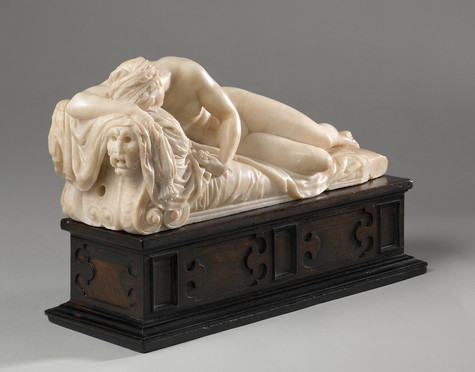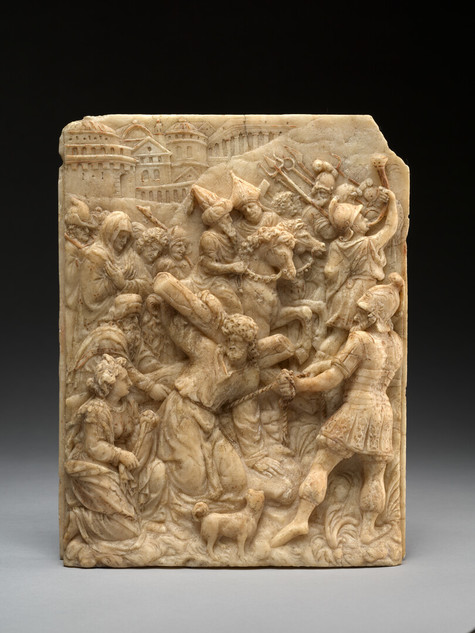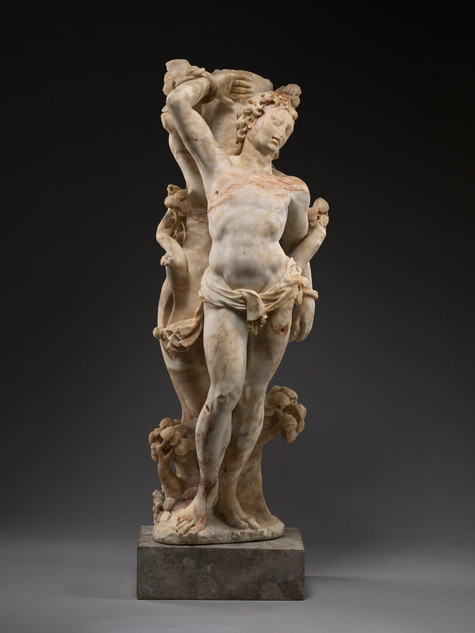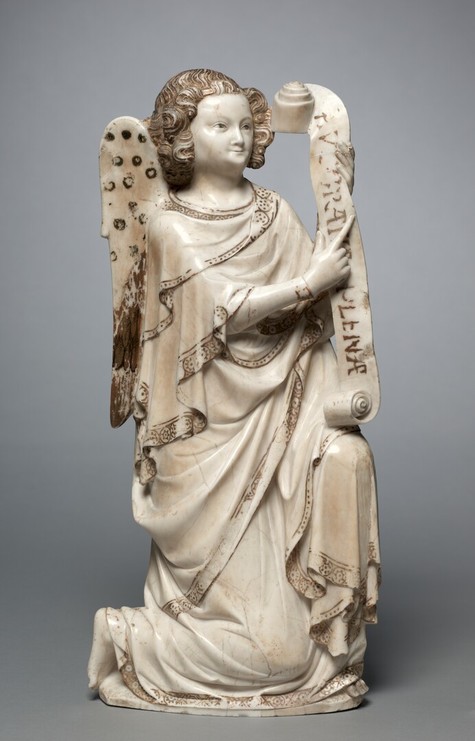A very special exhibition at M: 'Alabaster'
Alabaster

‘Sint-Annaretabel’, Robert Colyns de Nole II, 1610, albast, collectie M Leuven, foto: artinflanders.be, Dominique Provost
This autumn, a very special exhibition is running at M. Using more than 130 works, we tell the history of alabaster in Europe from its early beginnings in the 14th century to its peak in the 17th century. A must for all art lovers, not only because of the many unique pieces, but also because of the new light the exhibition and the research behind it shed on European art history.

‘Sint-Annaretabel’, Robert Colyns de Nole II, 1610, albast, collectie M Leuven, foto: artinflanders.be, Dominique Provost
Alabaster is the brainchild of Marjan Debaene of M and Sophie Jugie of the Musée du Louvre and also the first major collaboration between the two museums.
Sophie: "I am the director of the Département des Sculptures where I focus on sculpture from the 15th and 16th centuries. Alabaster is a special type of stone and was at the time a widely used material, but we noticed that there were gaps in our knowledge. For example, when the tomb of Philip the Bold in Dijon was restored, there appeared to be no way to trace where the alabaster came from. For some pieces, we were not even sure whether they were made of marble or alabaster! We also had an alabaster head in our collection that we suspected belonged to a statue of St Augustine from the monastery in Brou. But we still had some doubts, the head was fairly small in relation to the body."
"To find the answer to such questions, we launched a research programme in 2010 on the use of alabaster in France from the 14th to the 16th century, the great heyday so to speak. We felt it was especially important to be able to trace the origin of alabaster. That would allow us to situate works better."
"We partnered with the Laboratoire de recherche des monuments historiques. That belongs to the French Ministry of Culture and has a very competent geology department. Together with colleagues from the Bureau des recherches géologiques et minières, the researchers at the laboratory developed an isotope analysis. There already was an analysis for marble. We first tackled works that were well documented, and whose alabaster origins we already knew. With that, we tested the isotope analysis, and it turned out to be extremely reliable."
"Then we broadened the programme and started analysing works across France. We organised study days and published our results. Using classical art historical research, we were for example able to prove that that head did indeed belong to St Augustine and isotope analysis showed that the alabaster came from the Jura Mountains. We soon attracted the attention of other colleagues from across Europe. We also made contacts ourselves, including with Marjan. It was not lost on us that she has done formidable work on sculpture of the late Middle Ages. We saw each other at conferences, I visited her, we exchanged views, and one day she told me: 'Listen, I would like to organise an exhibition on alabaster.' I immediately replied: 'Brilliant idea!' (Laughs)"
New stories
Marjan (Department Head of Ancient Art at M): "We had already organised a congress on medieval sculpture together in Paris in 2017. We realised then that we work together very easily, not just talking about it, but organising it too. Besides, Sophie's team had all these fascinating results, and when you put together an exhibition, it is always good if you have new stories to tell. This research deserves to be shown, not only in specialised journals and conferences, but also in an exhibition for the general public."
Sophie: "Although, of course, we also hope that 'Alabaster' will attract the attention of other researchers. We have realised in recent years that many works have been misidentified in museum catalogues or databases. The difference between alabaster and marble is often hard to tell. People then think: it's white, it's polished - it must be marble. When researchers get to see the publication about this exhibition, they might start looking at it with a slightly different perspective. Who knows what things will turn up?"
Marjan: "The exhibition features one such work: St Catherine from Kortrijk, a Flemish masterpiece. There had long been doubt as to whether it was made of alabaster or marble. They used these terms interchangeably in the Middle Ages, which of course makes it all even more confusing. We first wanted to show the image as an illustration of that doubt, but then we thought: you know what, we'll have it examined, then we'll know once and for all. It turned out to be of English alabaster - really quite a significant result."

Gold worth
Sophie: "The ARDS network (Association for Research and Documentation on medieval and renaissance Sculpture) that M set up has also been very important for the exhibition. In the whole of northern Europe, they really know M as the museum that unites researchers. We don't have that at the Louvre you know. Naturally, there are contacts with colleagues in Brussels, Amsterdam, Frankfurt... But you can't really call that a network. Marjan is reaping the fruits of what she sowed years ago. We could never have put on the exhibition without all those researchers and curators connected via ARDS."
Marjan: "Our scientific committee was also gold worth. It was clear to us from the beginning that we wanted to hold an exhibition on alabaster in Europe, not just in France or the Low Countries. Fortunately, we have found experts from across Europe willing to assist us. During the preparatory meetings, they constantly made suggestions about pieces we could show. Take our Spanish expert, for example, Professor Carmen Morte Garcia of the University of Zaragoza. I think she literally knows all the alabaster pieces in Spain, where they are kept and who is responsible for them. All that help has allowed it to become a really great exhibition: 130 pieces, together accounting for 350 years of art history, from the 1300s to the 1600s. We pretty much took over the entire first floor of the museum. There will be many unique works on display, but we will also discuss isotope research and the material itself."

Naar een model van Jean Cousin, Grafmonument van Philippe Chabot, ca. 1543-1570, albast, Musée du Louvre, Parijs © RMN-Grand Palais (Musée du Louvre) / Stéphane Maréchalle

Caryatids from the former sacrament tower of the Celestine monastery in Heverlee: two putti, Cornelis II Floris, 1560-1563, photo: artinflanders.be, Dominique Provost









Warm stone
Sophie: "We explain how alabaster conquered Europe. Initially, it was a very exclusive material which was used at the French and English courts as an alternative to marble. It gradually seeped into other areas like churches and monasteries, the clergy, the aristocracy ... For example, we show a large tombstone from the Louvre's collection. It was made in the mid-16th century for Admiral Chabot, so not royalty in other words. At that time, alabaster had become fully established and because it was reasonably easily available even the aristocracy could order such spectacular works of art."
Marjan: "Alabaster was very often used for funerary monuments, and for images related to death. I think the 'Allegory of Death' at the exhibition is a very interesting piece. It is very morbid: a decomposing corpse, a skeleton with a few strips of decayed flesh left here and there."
Sophie: "That work was very well known and loved in Paris. It comes from the Cimetière des innocents, a now-defunct cemetery. Alabaster makes it possible to work in great detail, and thus render all those lurid elements in a realistic way. People also used to link alabaster to human skin, the human body: it has a slightly bit pinkish look and it feels warm when you touch it, not cold like marble. It is also fragile, if you leave it outside, it will quickly deteriorate - a parallel with decomposition. So a suitable material for grave monuments in other words."

Ile-de-France, ‘Allegorie van de Dood’, (‘La Mort Saint Innocent’), ca. 1530, albast, Musée du Louvre, Parijs © RMN-Grand Palais (Musée du Louvre) / Pierre Philibert
UK
Sophie: "Alabaster was also for a while the material of choice for retables, the large works of art you see above altars. In the Middle Ages, these were mainly carved from wood and the Low Countries were widely known for producing these. But alabaster gradually supplanted those wooden altarpieces, and centres of production for alabaster retables sprang up all over Europe: in England, in Bordeaux, in Poland, in Mechelen... They usually consisted of three, five or seven panels. At the exhibition, you can see a complete retable from England. This is exceptional because in the 19th century, a lot of panels were sold to art lovers piece by piece, that was a fad in the art market at the time."
Marjan: "We have a whole room dedicated to retables. There is a very fine work by Jean or Jehan Mone (1480-1554), master artist of Charles V and one of the first Renaissance sculptors of the Low Countries. He worked in Mechelen, which had become an important production centre for alabaster sculpture by the end of the 16th century. For example, they made small reliefs, devotional pieces for wealthy citizens for private use. You could almost speak of mass production, but all high quality work."

‘Martelarenretabel’, ca. 1450-1500, albast in latere houten omlijsting, The Phoebus Foundation, Antwerpen © Phoebus Foundation Antwerpen
Lumpy
Marjan: "In the first and last part of the exhibition, we also make a small excursion into contemporary art - because alabaster is still being used. We can't provide a complete overview of that because that would be a whole other exhibition on its own. But have included some pieces by Sofie Muller, an artist from Ghent who is fascinated by alabaster. In the first room, you see six psychological portraits, as she calls them, six heads for which she has used the imperfections of the material. Alabaster is usually found as a type of nodules. On the outside, these look rough, uneven and lumpy. You never know what you'll find on the inside: air bubbles, discolouration, a crack maybe... In medieval times, they would throw away nodules like that but Sofie uses the imperfections. She never knows what the end result will look like until it is finished."
"Especially for the latter space, she created a new work, a response to an absolute masterpiece from our own region and our own museum: the retable of St Anna from the Celestine Convent in Heverlee. A very impressive work consisting of fourtien bas-reliefs and is over six metres high. Saint Anna is the mother of Mary, and thus the grandmother of Jesus. Sophie's daughter also happens to be called Anna, which is why she has made alabaster statues of a kind of Saint Anna-Trio: her daughter, herself and her mother."
Sophie: "The retable of Saint Anna dates from 1610, just after the heyday of alabaster. There is a new period in art history dawning and artists are taking over from craftsmen with painting becoming the main art form. Retables are now mainly painted, funerary monuments are becoming rarer, and marble is starting to supplant alabaster. The retable of Saint Anna is one of the last highlights of alabaster production, certainly in the Low Countries. It's also a local piece. A perfect way to close the exhibition with."
The exhibition was made possible in part thanks to the support of M-LIFE and Bank Delen.
What is alabaster?
Alabaster is a generally white stone very similar to marble. It is considerably softer, however, and so easier to work with. There are quite a few sites in Europe, including north of the Alps. So it was easier to find than marble: that had to be brought from Italy via the Mediterranean Sea and the Atlantic coast to northern Europe.
Alabaster does have one major drawback: it dissolves in water, making it unsuitable for outdoor sculptures and works of art.

'Trinitas Terrestris', Sofie Muller, ANNA /001–004/22, 2022, albast, privécollectie Gent © Sofie Muller, foto: Cedric Verhelst
Isotope analysis, you say?
To clarify what isotope analysis is, we need to go back to secondary school chemistry for a moment. An atom consists of a nucleus of protons and neutrons surrounded by a cloud of electrons. The number of protons determines which element it is. If there are two protons, for example, you have helium, with 29 you have copper. However, the number of neutrons in the nucleus may vary. For example, copper occurs with 34 and 36 neutrons. Atoms with the same number of protons but a different number of neutrons are known as isotopes. The ratio of different isotopes of the same element usually varies from site to site. So in principle, with an analysis of well-chosen isotopes, you can trace where something has come from.
Researchers at the French Laboratoire de recherche des monuments historiques succeeded in assigning alabaster to a site with great precision using with isotopic analysis of the chemical elements oxygen, sulphur and strontium.



